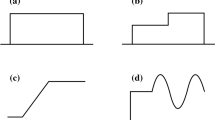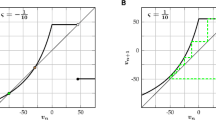Abstract
When a rate histogram is used to represent the firing pattern of a neuron there is the potential for serious error due to aliasing, and because of this the rate histogram is a very poor way to represent neural activity. It is theoretically possible to encode a signal in a spike train and decode it without error by filtering and sampling. There is no natural optimal filter design for this problem, but it is possible to specify the characteristics of a good rate estimating filter heuristically and design a filter with these characteristics. Two rate estimating filters are described here. Their performance has been tested, and compared to the rate histogram and the French-Holden rate estimating algorithm, by measuring their ability to recover signals encoded as impulse sequences by Integral Pulse Frequency Modulation (IPFM). These filters are simple to implement and perform well. They should be used in preference to the rate histogram.
Similar content being viewed by others
References
Bayly EJ (1968) Spectral analysis of pulse frequency modulation in the nervous system. IEEE Trans Biomed Eng BME-15:257–265
French AS, Holden AV (1971) Alias-free sampling of neuronal spike trains. Kybernetik 8:165–171
Hamming RW (1983) Digital filters. Prentice-Hall, Englewood Cliffs, NJ
Peterka RH, Sanderson AC, O'Leary DP ( 1978) Practical considerations in the implementation of the French-Holden algorithm for sampling of neuronal spike trains. IEEE Trans Biomed Eng BME-25:192–195
Author information
Authors and Affiliations
Rights and permissions
About this article
Cite this article
Paulin, M.G. Digital filters for firing rate estimation. Biol. Cybern. 66, 525–531 (1992). https://doi.org/10.1007/BF00204117
Received:
Accepted:
Issue Date:
DOI: https://doi.org/10.1007/BF00204117




